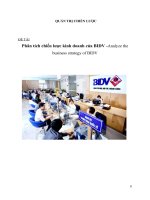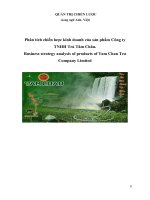PHÂN TÍCH CHIẾN lược KINH DOANH của NESTLÉ e
Bạn đang xem bản rút gọn của tài liệu. Xem và tải ngay bản đầy đủ của tài liệu tại đây (122.57 KB, 14 trang )
PHÂN TÍCH CHIẾN LƯỢC KINH DOANH CỦA NESTLÉ.
NESTLÉ'S BUSINESS STRATEGY.
1
TABLE OF CONTENT
TABLE OF CONTENT................................................................................................2
INTRODUCTION........................................................................................................3
RESEARCH OF CONTENT........................................................................................4
1. Introduction of the Nestlé company..........................................................................4
1.1 Overview of the Nestlé company............................................................................4
1.2 Establishment history and development..................................................................4
1.3 The business philosophy.........................................................................................6
1.4 The values and principles, business standards of Nestlé:........................................7
2. Introduction to Nestlé Vietnam.................................................................................8
3. Nestlé's business strategy..........................................................................................8
4. Studies coffee products of NESCAFÉ.....................................................................10
4.1 Formation and development..................................................................................10
4.2 The position current...............................................................................................11
5. Analysis of the business environment.....................................................................12
5.1 Interests of consumers...........................................................................................12
5.2 Pressure from governments...................................................................................12
5.4 Technological innovation, access to supplies........................................................13
CONCLUSION...........................................................................................................14
2
INTRODUCTION
Currently the company in Vietnam is also facing challenges enormous. Conceived
in a young economy, companies in Vietnam has not had much experience against the
crisis and the increasingly fierce competition from rivals in the world. Therefore, we need
to look closely at the strategies of large companies have much experience to learn and to
find alternatives to deal in order to maintain and grow the business. With head adept in
recognizing the opportunities and challenges before the global recession now, the
operator of Nestle - one of the giant transnational corporations in the world- are
implementing powerful transformation step for the company and earned a lot of success.
The Nestle study will give us the ability to make decisions and proper measures for
development company, holds a competitive advantage. Moreover, Vietnam be accorded
the abundant raw materials for manufacturing, where international companies (including
Nestle) is heading to exploitation.
Nescafe is one of the flagship brands of Nestle. Nestle spent a lot of resources and
support for the development of this brand. With construction projects Nescafe factory in
Vietnam, the company Nestle is set production and processing of coffee in Vietnam in a
difficult position. If not equip themselves with the necessary knowledge, set out the
appropriate strategy, the company in Vietnam will quickly fail in their home market. I
decided to study coffee is found as this is one of the strengths of Vietnam should be used
to put the country's economy going up.
Although the company is currently focused on developing world field marketing
but marketing strategies will never work if the other parts are not operating effectively.
Each department in a company are decisive factors of success of the company. In
individual assignments, I would mention the business strategy. This strategy plays a very
important role. In the current crisis, the production company business with particular
emphasis of this strategic adjustment. There is an appropriate business strategy will put
the company ahead of the competition, bringing the cost advantages, advantages in
customer satisfaction for the product.
3
RESEARCH OF CONTENT
1. Introduction of the Nestlé company
1.1 Overview of the Nestlé company
Nestlé (Nestlé S.A. or Société des Produits Nestlé SA) is headquartered in the city
of Vevey, Switzerland, is a multinational food and nutrition world's largest with a total of
250,000 employees and 500 plants worldwide. Founded in 1866 by Henri Nestlé,
currently the company's products have been worn in most countries around the world.
The scope of the company's product line from coffee, water, ice cream, baby food
and to implement health and nutrition care, pet care, confectionery and pharmaceuticals.
The main brands include Nestle Nescafe, Perrier, Nestea, PowerBar, Cuisine and Toll
House.
By experience and business strategies, the leaders of Nestle cope with the
challenges brought growing corporations and powerful nations themselves reach out
across the continent and around the world. Nestle has always had a breakthrough in
business as well as in market research to increasingly demonstrate its number one
position in the food sector in the world.
1.2 Establishment history and development
- In the period 1866-1905: In 1860, pharmacist Henri Nestlé invented a food for
babies can not be breastfed. His first success was rescued a preterm baby can not be
breastfed food or other common alternative. The value of this new product quickly
recognized since the new formulation of Nestlé premature babies survived. Since then,
Nestlé infant formula Farine Lactée Henrie has been widely sold in Europe.
- In the period 1905-1918: 1905, Nestlé merged with the company producing
Anglo-Swiss milk. Since early 1900, the company was operating factories in the United
States, Britain, Germany and Spain. World War I created a new source of demand for
dairy products in the form of government contracts. End the war, Nestlé's production
level was more than doubled.
- In the period 1918-1938: After of World War, the government contracts with
consumers run out and quickly returned with fresh milk. However, Nestlé team has
responded quickly, organizing effective operations and reduce debt. In the 1920s, Nestlé
4
began expanding into the manufacture of new products and chocolate become an
important sector of the Nestlé second.
- In the period 1938-1944: Nestlé immediately notice the effects of World War II.
Profits fell from 20 million dollars in 1938 to 6 million dollars in 1939. The factory was
located in the developing countries, particularly Latin America. Surprisingly, the war has
helped the company to introduce new products, Nescafé drinks mainly of the US military.
The output and sales of the Nestlé rose quickly in wartime.
- In the period 1944-1975: End of World War II was the beginning of an active
period of Nestlé. Nestlé Continuous rapid development and acquisitions many
companies. In 1947 approaching merger with manufacturer Maggi seasoning and soup. In
1960 the Cross & Blackwell and in 1963 to turn Findus, Liffy's in 1971 and Stouffer's in
1973. Nestlé began to diversify products while holding shares in L'Oréal in 1974.
- In the period 1975-1981: The development of Nestlé in market developing
country partially helped offset the decline of the Company on the traditional market.
Nestlé speculative conduct a second outside the food industry by acquiring Alcon
Laboratories Inc. Company
- In the period 1981-1995: Nestlé gave up some business from 1980 - 1984. In
1984, the key improvements in the operation of the company has allowed Nestlé to
conduct new acquisitions, the most important is the acquisition of "giants in the US food
industry" Carnation.
- In the period 1996-2002: In the first half of the 1990s was a period favorable for
Nestlé: trade barriers were lifted, world market development into regional trade
integration. Since 1996 the company has acquired companies such as San Pellegrino
(1997), Spillers Petfoods (1998) and Ralston Purina (2002). Two acquisitions largest in
North America took place in 2002: in July, Nestlé merged businesses their cream in the
United States in the company Dreyer's, and in August, announced acquisitions Corporate
Chef America with price is 2.6 billion dollars.
- In the period of 2003 - up to now: in 2003 was a good start by acquiring
Mövenpick ice cream manufacturing company, strengthening its position in the world
Nestlé's head in this sector. In 2006, Nestlé invested in Jenny Craig and Uncle Toby's,
and until 2007, Novartis Medical Nutrition companies, Gerber and Henniez also be
merged into Nestlé.
5
1.3 The business philosophy
1.3.1Recklessness and daring to develop
"When you stop growing means you start dying," said Peter Brabeck, Nestlé's
business manager confirmed. Over 20 years, Nestlé has not stopped growing and
expanding worldwide, crush many competitors and a turnover of USD 98 billion, profit
before tax of 11 billion Swiss francs in 2003. Brabeck became CEO of Nestlé in 1997
still want corporations continue to expand further. His goal is to increase annual sales to
90 billion Swiss francs.
1.3.2 No change to change all
The first thing to go was decentralized. Nestlé began to consolidate the leadership
of the factory in each country in the region, combined supervision of similar products in
the "unity of business strategy."
Executive Nestlé to the global consensus without losing the ability to adapt
products to each market. Currently, the company produces more than 200 different kinds
of coffee Nestlé to suit the taste of customers worldwide.
Nestlé is one of the largest companies in the world, turned into a global
corporation effectively with strong management, Nestlé will continue far longer.
1.3.3 The quality
Product quality is the top priority of Nestlé. As a company that nutrition, health
and healthy living, Nestlé is committed to providing consumers with high quality
products suitable for each age group. Nestlé not interested in taste but also focus on the
nutritional aspects of the product to deliver to the consumer's health.
Currently, Nestlé is a multinational food budget and nutrition research centers the
world's largest. The scientific know-how combined with experience over 140 years in
manufacturing various foods under the brands reputation gave Nestlé a unique position in
the field of global nutrition. Nestlé brands in each product is a commitment to food
safety, compliance with all current regulations and standards of quality.
1.3.4 Environment
Nestlé commitment to doing business with awareness of environmental protection
and contribute to the sustainable agriculture initiatives. Nestlé pays great attention to the
environment protection, considering it as a responsibility to society and the community.
6
The factory of Nestlé aims to minimize the amount of water and energy used in
production.
1.4 The values and principles, business standards of Nestlé:
1.4.1 The common principles
The principle business of the Group will continue to be developed before the
changes going on in the world, however, these principles are expressed the basic ideas of
fairness, honesty and relationships common interest for everyone.
1.4.2 Principles of management and leadership of Nestlé
Is a very human company, Nestlé always meet the essential needs of man on
Nutrition and Health. This view is reflected in the style and encourage managers and
leaders throughout the company. Besides, respect for different cultures and values of all
foundation staff is essential for success in business and for the company culture. Nestlé is
also a Swiss company inherited many values are developed in Switzerland in the past
century.
Accordingly each Nestlé managers are required motivate and mobilize employees,
seeks to improve the way you work, create the atmosphere change, promote innovation.
They are experiencing personal experience working in an international environment,
always respecting the cultures of the world, respect towards the long-term strategic
approach, rather than the short term.
1.4.3 Principles of communication to consumers
In the communication, Nestlé has always respected cultural and local values,
always honest and uphold the healthy nutritional habits. This is especially important for
small children. Nestlé is committed to the principle of not advertising directly to children
6 years of age. With products for ages from 5 to 12, only communication to children if
products meet strict nutritional standards and most have adequate nutrition category with
this age. Nestlé accelerate the reduction of sugar, salt and fat without health benefits of
these products while promoting balanced diet and healthy lifestyle.
1.4.4 The standards of business ethics:
Business ethical standards give specific guidance for each employee on how to
implement business rules. This standard emphasizes further the need to act lawfully and
honestly, putting corporate interests above personal interests, fight against bribery and
corruption, has always shown integrity at highest.
7
2. Introduction to Nestlé Vietnam
Nestlé arrived in Vietnam for the first time in 1916. Over the decades, products
such as: GUIGOZ, MONT- BLANC LAIT, MAGGI have become familiar to generations
of consumers Vietnam. Nestlé returned to Vietnam in 1990, and opened a representative
office in 1993.
In 1995, Vietnam Nestlé Company Limited (100% foreign capital) was
established, under Nestlé SA. Also in 1995, Nestlé licensed establishment Dong Nai
plant, specialized in manufacturing NESCAFÉ soluble coffee, instant tea and packaged
drinks NESTEA MILO, NESTLÉ nutritious cereal powder, MAGGI seasoning and
dipping sauce, COFFEE-MATE cream powder.
Vietnam Nestlé Company is headquartered in Ho Chi Minh City and sales offices
in Hanoi. Nestlé has Dong Nai factories in southern. Currently total employees of Nestlé
Vietnam up to 1000 people. Over the years, Nestlé has attracted and trained a person
workforce Vietnam qualified to meet the needs of business development of the company.
Activities in Vietnam:
- Office of Nestlé's first business in Saigon was founded in 1916. Here are the
milestones recorded the rapid development of the company in Vietnam:
- In 1992: La Vie Company, a joint venture between Nestlé and Perrier Vittel
under a trade company Long An was established.
- In 1993: Nestlé Vietnam officially back and opened a representative office in Ho
Chi Minh City.
- In 1995: Nestlé Vietnam born. Officially started construction of factory in Dong
Nai.
- In 2002: Putting into operation the second plant of La Vie in Hung Yen.
- In 2007: Selection Dielthem official distributor for chocolate products and
confectionery.
- In 2008: Establishment of Special Nutrition Division.
3. Nestlé's business strategy
To be able to sustainable development and exploiting the opportunities and
overcome the difficulties of globalization, Nestlé has adopted many international
business strategy for each type of product and each market. As a large multinational
company with many international brands, Nestlé is not too rigid in applying their
8
strategies. According to some documents, Nestlé has applied multi-domestic strategy. The
following strategies can help Nestlé to adapt to each specific market, to meet the different
needs of consumers and thus enhance competitiveness, the SBU of Nestlé has high
independence. In the case of Nescafé, the factory, the company's branch in the country is
entitled to make decisions on many aspects such as price, output, product type, raw
material supply, distribution systems,etc,... adapting a domestic brand or product to suit
local market conditions, sometimes resize package or product innovation to make it more
appealing to local consumers. Monitoring of excessive or directives from the
headquarters will not only limit the discretion of the local administration, but also affect
the local brand. Nestlé intensive use of local managers to diverse activities around the
world together, companies based include 700 managers who spend most of their careers
on foreign assignments, moving from one country to "foreign troops". The company
owns 8,500 brands, but only 750 people of which registered in many countries, and only
80 registered in more than 10 countries. While other companies will use a global brand in
many developing markets, Nestlé focused on trying to optimize the components and
processing technologies to local conditions and then use a name brand resonates locally.
And globalization are key to the company's strategy in the emerging markets.
The conclusion Nestlé applied such strategy for Nescafé domestic market as
shown by the company only put 11 out of 27 plants in the coffee producing countries.
Thus 16 factories in other markets do not meet the needs of cost savings the company
that primarily because adapting to the local market. However, Nestle closed 38 factories
demonstrates companies are interested in reducing the cost to bring greater
competitiveness in crisis, recession and fierce competition today.
Today, multinational companies global reach by acquiring local brands with very
large portfolios, unbalanced. The other point that is applied Nestlé's global strategy to
make use of material resources in the country. These are measures to help Nestlé to cope
with the difficulties ahead. Evidence that in recent years, two-thirds of Nestlé's growth
came from acquisitions. But besides that also brings some problems for Nestlé because
the large portfolio from the acquisition and development of global distribution and
marketing network, ie on the basis of brand powerbrands market Leading been
recognized in almost every country around the world. The main aspects of the global
strategy include:
9
- Stable global markets as the domestic market.
- Create a global marketing mix, while recognizing regional differences and
countries, such as differences in language and tastes.
- Creates production and global distribution systems, such as superfactories
include large areas of the world.
- Focus on powerbrands - most successful brands and products. Because the global
market is huge there are significant benefits gained from economies of large-scale
marketing, manufacturing and distribution. Instead of producing thousands of different
products, narrowing the scope of a much smaller amount to support this global brand.
However, Nestlé does not just stop at the standardized products that offer multiple
product lines with many different categories to provide greater customer satisfaction. So
the book Foundations in Strategic management, the authors see Nestlé as an example of
companies implementing transnational strategies. Adopting strategies allow transnational
companies can pursue two objectives that meet the needs of consumers and cost savings.
This strategy has the advantage of learning and mutual transfer of experience in the
global system. However, resource companies scattered across the board makes it difficult
for management. Really the Nestlé is working on what strategy is difficult to determine.
But the results of the application of this strategy is to grow market companies and
provide optimal profit.
4. Studies coffee products of NESCAFÉ
On average in the range of Nestlé, Coffee is considered a successful product line
and bring more profits for the company. The evidence is that its introduction has created a
revolutionary coffee-drinking habits of people around the world and has been rated as
one of the types of instant coffee powder leading drink.
4.1 Formation and development
In the world's only brand Nescafé value is quantified by a much larger amount
than the value of the corporation that owns it. Nescafé officially born on April 1, 1938
and is now the most expensive brand of all brands of Switzerland. However, the launch
of Nescafé have originated from Brazil.
In the 20s of the 20th century, coffee in South America, particularly in Brazil are
rich harvest. To keep the coffee price is reduced by oversupply, measures often used as
coffee dumped into the sea. In 1930, the Brazilian government trust Nestlé find out how
10
to prepare coffee to preserve the quality that keeps the flavor and taste for a long time. At
that time, coffee was common and widespread, but has formed groups to enjoy gourmet
coffee and caste discrimination in coffee. Therefore, keep the aroma and taste
characteristics of the coffee quality is the most decisive factor in the long-term
preservation rather café diversification instant coffee product. The problem faced by
Nestlé requires solution combines term solution with long-term sustainable solutions.
After 7 years of research and experimental tinkering, its research group around
Max Morgenthaler chemists have succeeded with a very simple idea, but deserves to be
considered a genius of soluble coffee: use material protected was almost entirely full of
flavor and taste of the coffee, make coffee and easy long-term storage medium is very
convenient to use. 65 years later, in the world every second clock instant coffee cup 4100
so the people drink. A new brand was born from orders of Brazil. Café continued
conquest of the human world and the brand Nestlé get help earn extra money and more
fame.
Nescafé is a composite name from the name Nestlé and Café. Early, soluble coffee
product is mainly used in the military to help soldiers awake, especially for pilots and
drivers. After the war, new Nescafé became popular in the country, first in the country
with the presence of the US military. From the 50s of last century, the youth discovered
Nescafé and fans, primarily because of the convenience to use and has even been said
that real coffee flavor than filter coffee maker. The road became brightest brands in the
world brand almost no obstacles anymore for Nescafé.
4.2 The position current
In the most recent ranking of brand value in the world by Interbrand agency
announced, Nescafé No. 30 with 12,115 billion value while Nestlé owns it No. 55 with
6,613 billion in value.
Start with the Brazilian government contacted Max Morgenthaler, a coffee expert,
in the early 1930s with the request is seeking to create a cheaper type of coffee you can
drink immediately by just adding water boiling, for all the coffee consumed yearly
surplus grain in this country.
Since then, the brand has always focused on breakthrough innovation in coffee
enjoyment with types such as pure soluble coffee only use roasted coffee beans, in 1952),
the coffee drying - frozen soluble (with label type Nescafé gold, in 1965) and coffee grain
11
(in 1967). In 1994, they invented the process retain the aroma, a significant quality
improvement for drinking instant coffees.
This breakthrough innovations have secured the leading position of the brand
Nescafé instant drink coffee market in the world. It is also the brand's second largest
water world after Coca-Cola, with about 3,000 cups consumed each second. However,
the breakthrough can not be the only factor bringing overwhelming success, Nescafé
must also do its utmost with the marketing and advertising campaigns aimed at niche
markets in order to maintain its position. This brand is regarded as an expert in
employment increased more among brand values. For example, in the UK, both Nescafé
and Nescafé brand Gold Blend.
5. Analysis of the business environment
5.1 Interests of consumers
Ability to consume food products in general and coffee in particular were
influenced by the preferences of local consumers. These preferences are formed from the
cultural history or from local natural features. Moreover, different people have different
tastes, but overall coffee in a given country, the majority of people who share a taste. For
example, in a small country like Switzerland, there are differences in taste middle
Jurassic German speaking and French-speaking regions. In French-speaking areas,
customers prefer black coffee and darker while the German-speaking Switzerland (and
German) enjoys mild milk coffees.
To meet the different conditions in the country, managing the global Nestle factory
has a certain autonomy. Decision procurement, production, marketing, and pricing is
done locally in each country, whether it be Britain, Poland, Australia, or any other
market. Headquartered in Vevey only a coordinating role.
5.2 Pressure from governments
The political environment is the decisive factor in the ability of a company's
successful international business, such as Nestle. When involved in a potential market,
Nescafe inevitable competition from rival companies or major multinationals from other
domestic companies. To protect the interests of their country, governments in some
countries creates some barriers to trade, making it difficult for the market development.
So, for all to be able to enter the market better potential, while building good image of the
brand Nescafe, Nestle has built factories in the country immediately. Has recently taken
12
measures to deal with trade barriers and enlisted the support of the government and local
people by exploiting local resources.
5.4 Technological innovation, access to supplies
Premises global technology generally equal between the companies, hence the
technological innovation is too important not important above all to put that technology
access and material supply source close consume. Nestle change the factory has its long
history to build high-tech factories in the country that offer the potential for material and
product requirements. The program "beyound the cups" of Nescafe is the best example of
how companies generate their supply. This can be considered as methods of ensuring
effective quality materials and construction company image. This support program for
farmers in countries with Nescafe factory approach with similar scientific, technical and
quality coffees. Then the company acquired green coffee prices are relatively high
compared to competitors.
13
CONCLUSION
To reach its current position in the market, Nestlé has gone through a long process
of searching for the path consistent with the nature of the company as well as the general
situation of the economy. Therefore, every step of the food group leading the world, are a
testament to the correctness of their strategy. For international production strategy,
success is a combination of process research and development, production positioning
and decision logistics chain resources and global effectiveness.
Cause runaway success in the coffee industry that the team can be summed up as
follows: First, locate the scattered production, in line with the organizational structure
and nature (as multinationals food processing industry) of companies. Secondly, adequate
investment for R & D and focus on the diversity that international market demands.
Thirdly, apart from material acquisition strategy combined with measures to ensure
sustainable supply. Fourthly, outsourced logistics services serving the needs reality in
each country and the application of new technologies in logistics.
From the footprints ahead of giants Nestlé, enterprises in Vietnam can fully draw
lessons for themselves, for promoting production, development, and set the proper first
steps when carrying penetration into the vast world market. Here are some lessons that
the team proposed for businesses in Vietnam today:
+ Option produce consistent strategy with resources and their availability status.
Considerations when choosing plants open position to exploit the comparative advantage
of that locality, value chain optimization. Constantly developing new products to
diversify customer's choice and adapt to consumer culture of different localities. If global
manufacturing enterprise, it should pay more attention to the distribution of R & D.
+ Link or acquisition of major brands to expand product lines, expanding the
market. More emphasis on the issue of secure supplies. If funded entirely from outside,
businesses need to take measures to ensure an annual purchasing volume, input quality
assurance by close links with more farmers. If companies are not enough resources, to
consider a hire external logistics service to increase professionalism and decrease labor
costs, warehousing,etc,...
14









